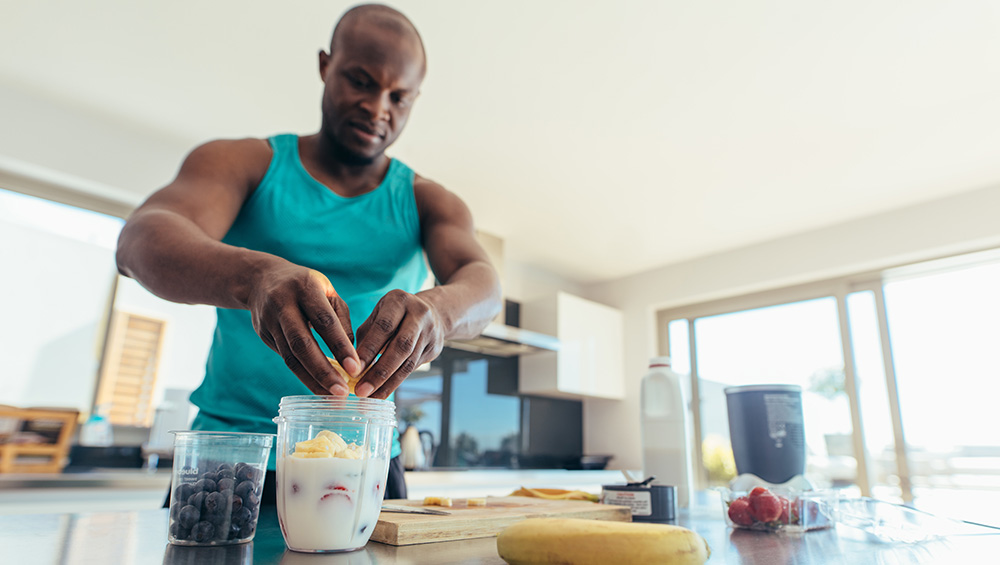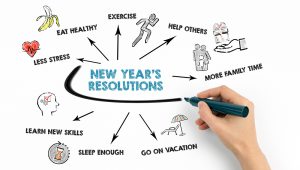What to eat after exercise for optimal refueling and recovery.
No matter why you’re exercising—whether it’s to build muscle, lose weight, have more energy, or prevent disease—you’ll maximize your results if you refuel properly post-workout. Choose the wrong foods, skimp on nutrients, or overeat and you could negate all of your hard work at the gym. You may also feel fatigued, and you’ll have less energy for your next workout. You may also be at a higher risk for injury if you’re dehydrated and not adequately fueled.
“Many people think that they’re getting stronger when they’re working out, but workouts actually break down the body, creating microfiber tears in muscles,” explains certified sports dietitian Tim DiLeo, R.D, C.S.S.D. “Nutrition helps the body to recover and rebuild stronger. After a workout, your body is like a sponge and will soak up the nutrients you provide it. High-quality, nutritious foods are necessary for optimal results.”
Three key components of post-workout refueling and recovery are rehydration, rebuilding muscle, and refueling muscle glycogen stores. But how much you need of each depends on the types and intensity of exercise.
Rehydrate. You lose fluids when you work out, even if you’re not sweating. No matter what type of exercise you’re doing, everyone should be replacing fluids post-workout. For most, water is sufficient. Kicking up the intensity or working out in hot conditions may require more fluids and ones that provide electrolytes like sports drinks. Being dehydrated can cause headaches, fatigue, irritability, and even increase your hunger and risk of injury.
Rebuild muscle. Proteins are the building blocks of muscle. A primary way that muscles become stronger is by repairing the microtears that occur when muscles are challenged. Protein is necessary to repair and rebuild muscle, so it’s essential to eat high-quality, easy-to-digest protein such as whey or pea protein powder, yogurt, or eggs after exercising, especially if you’re lifting weights to build more muscle.
Replace muscle glycogen stores. Glycogen is the stored glucose (sugar) in your muscles that provides energy. The longer and harder you exercise, the more you deplete these stores. Eating carbohydrates like grains, pasta, rice, fruits, and vegetables will replenish your body and keep your energy up, but balancing how much and what kinds of carbs to choose is important, especially if your goal is to lose weight.
To help you balance your post-workout nutritional needs and enhance the effects of exercise, here are refueling guidelines based on your goals and the types of workouts you’re doing.
High-Intensity, Long-Duration Strength and Cardio Workouts
This includes exercise lasting more than 60 minutes like boot camp or CrossFit workouts, indoor cycling classes, and long runs, rides, or swims. Also included are strength training workouts like lifting weights, even if they are shorter than 60 minutes.
- Rehydrate: These are workouts where you need something more than water, such as an energy drink. However, if weight loss is a goal, you’ll need to be careful that you’re not drinking back too many of the calories you just burned. Usually, 16 to 24 ounces immediately following a workout is adequate. However, if you’re sweating profusely, exercising in hot conditions, or training for an endurance event, you might need more. The best way to determine how much fluid you need is to weigh yourself before and after your workout. Then replenish based on the amount of weight you lost, drinking 16 to 24 ounces for every pound lost. Recommended low-sugar energy drinks: Powerade Water, Gatorade Zero, DripDrop, Liquid IV, Nuun Tablets
- Rebuild: Muscle breakdown is likely happening during these workouts, so it’s critical to eat 20 to 40 grams of high-quality, easy-to-digest protein within an hour of exercise. Greek yogurt, eggs, skinless chicken or turkey, high-protein filtered milk (Fairlife or Chobani), or a smoothie with whey or pea protein powder.
- Replace: To shore up glycogen stores that get drained during these workouts, aim for a 2:1 ratio of carbohydrates to protein within an hour post-workout. If you’re eating 20 grams of protein, combine that with 40 grams of carbohydrates. Low-fiber carbohydrates like white rice, potatoes, 100% juice, fruit, dried fruit, sports gels or gummies, cereal, or granola bars are best during this time to provide you with quick energy.
- Sample post-workout snack:
- Banana & Peanut Butter Wrap: 8-inch tortilla + 1 medium banana + 2 tablespoons of peanut butter or other nut butter + drizzled honey (optional)
- 12 oz chocolate filtered milk (Fairlife or Chobani) which has more protein and less sugar than regular milk
- 16 oz of water or low sugar sports drink
Continue refueling within two hours of your post-workout snack with a meal that contains protein, whole vegetables and fruit, and complex carbohydrates like quinoa, brown rice, or whole-grain pasta.
Strength Workouts and High-Intensity, Shorter Cardio Workouts
This includes moderate-intensity strength workouts like lifting weights or an hour-long power yoga class and shorter (less than an hour), sessions like a fast run, ride, swim, or high-intensity interval training.
- Rehydrate: Water is usually sufficient unless conditions are hot. Aim for 16 to 24 ounces immediately following your workout.
- Rebuild: Consume 20 to 40 grams of high-quality, easy-to-digest protein within an hour of exercise. Protein powders (whey- or plant-based) mixed into a beverage or a smoothie are an easy way to get the recommended amount of protein.
- Replace: These types of workouts won’t deplete your glycogen stores as much longer, more strenuous workouts. The carbohydrates from your protein-based snack should be enough, as long as you eat a meal within two hours.
- Sample post-workout snack:
- Yogurt Parfait or Smoothie: 1 cup of vanilla low-fat Greek yogurt + 1/2 scoop of vanilla protein powder + 1 cup of fresh berries + 1 tsp chia seeds (optional). You can add 1 cup of water/low-fat milk/dairy-free milk + ice for a smoothie
- 16 to 24 oz of water
Continue refueling within two hours of your post-workout snack with a meal that contains protein, whole vegetables and fruit, and complex carbohydrates like quinoa, brown rice, or whole-grain pasta.
Moderate- to Low-intensity Workouts
This includes brisk walking, most yoga, Zumba and Barre classes, and moderate running, biking, and swimming.
- Rehydrate: This is the primary component to focus on for these types of workouts. Water is usually sufficient unless conditions are hot. Aim for 16 to 24 ounces immediately following your workout.
- Rebuild & Replace: These types of workouts don’t cause a significant amount of muscle breakdown or glycogen depletion. If you can eat a meal within an hour of exercising, you can skip the post-workout snack. Your meal should contain protein, whole vegetables and fruit, and complex carbohydrates, such as chicken or fish with quinoa and veggies. If your next meal is more than two hours away, have a small snack with some carbohydrates and protein.
- Sample post-workout snacks: Only if you can’t eat a meal within about two hours.
- 1 to 2 ounces of beef jerky
- 12 ounces of filtered milk (Fairlife, Chobani, Ripple) which has more protein and less sugar than regular
- 1 cup of low-fat Greek yogurt with fruit
- Low added sugar protein bar (Quest, ONE Brand)
- Egg white scramble with veggies
- 6 to 12 grams of essential amino acids (AminoFormula, Klean Essential Aminos) mixed in 12 to 16 ounces of water (This is a good low-calorie choice if weight loss is a goal.)
If weight loss is your goal, choose lower-calorie options, such as essential amino acids, protein powders, and water, no matter what type of workout you’re doing. It’s easy to overestimate how many calories you’re burning and even easier to underestimate how many calories you’re consuming. You don’t want to eat back all the calories you just burned.
 Mindful Sodexo
Mindful Sodexo 




0 Comments